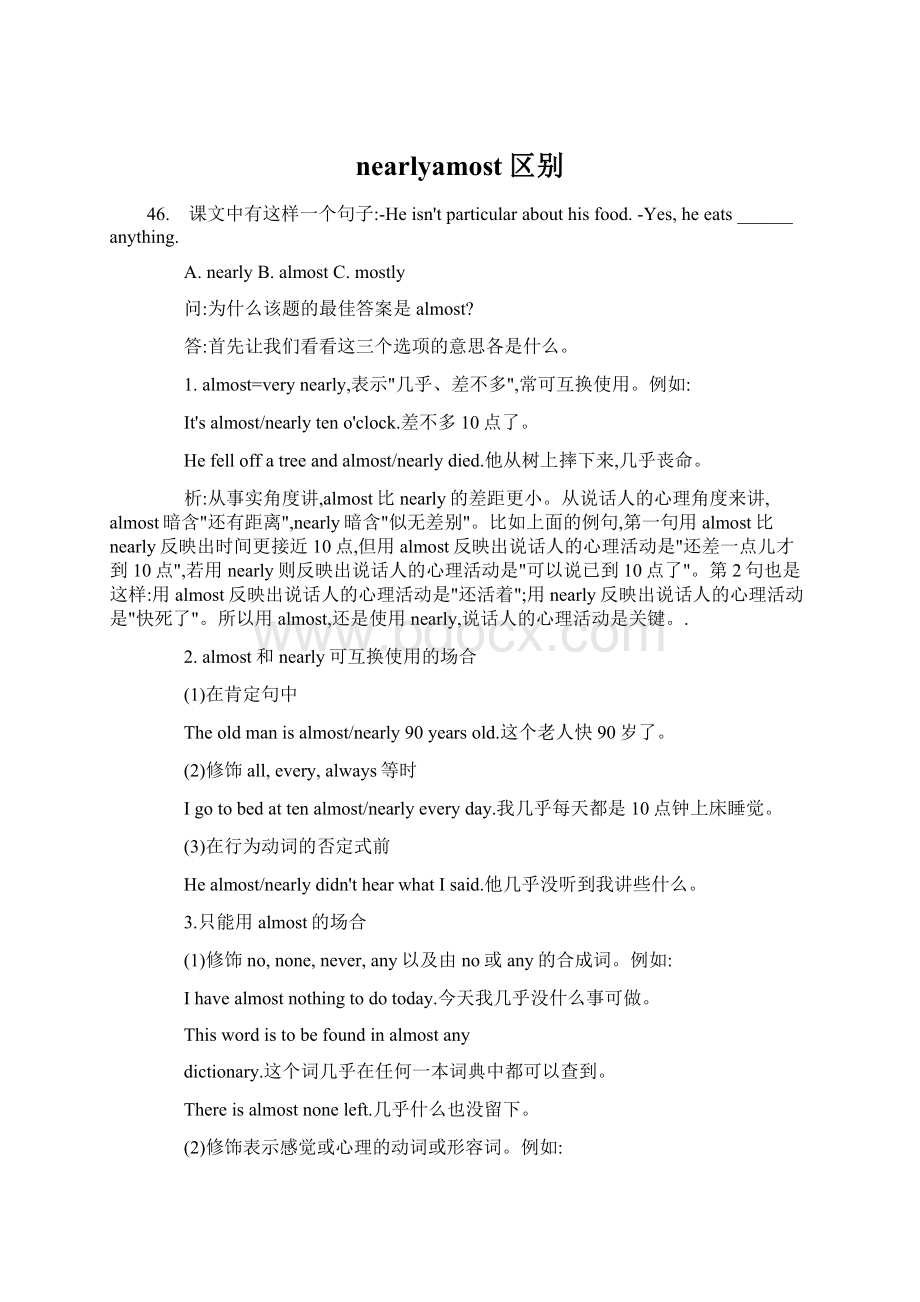nearlyamost区别Word格式.docx
《nearlyamost区别Word格式.docx》由会员分享,可在线阅读,更多相关《nearlyamost区别Word格式.docx(21页珍藏版)》请在冰豆网上搜索。

用almost反映出说话人的心理活动是"
还活着"
;
用nearly反映出说话人的心理活动是"
快死了"
所以用almost,还是使用nearly,说话人的心理活动是关键。
.
2.almost和nearly可互换使用的场合
(1)在肯定句中
Theoldmanisalmost/nearly90yearsold.这个老人快90岁了。
(2)修饰all,every,always等时
Igotobedattenalmost/nearlyeveryday.我几乎每天都是10点钟上床睡觉。
(3)在行为动词的否定式前
Healmost/nearlydidn'
thearwhatIsaid.他几乎没听到我讲些什么。
3.只能用almost的场合
(1)修饰no,none,never,any以及由no或any的合成词。
Ihavealmostnothingtodotoday.今天我几乎没什么事可做。
Thiswordistobefoundinalmostany
dictionary.这个词几乎在任何一本词典中都可以查到。
Thereisalmostnoneleft.几乎什么也没留下。
(2)修饰表示感觉或心理的动词或形容词。
Ialmostthinkyouareright.我还不完全相信你是对的。
(3)修饰morethan和too。
That'
salmosttoomuch.这简直是太过分了。
4.只能用nearly的场合
(1)被very,not,pretty修饰时。
I'
mnotnearlyready.我还没有准备好。
Iknowprettynearlyallthesecretsofhismarriedlife.我几乎知道他的全部婚姻生活的秘密。
注意:
notnearly=farfrom,muchlessthan差得远,远远不够。
Thereisnotnearlyenoughmoneyforanewcar.买一部新车的钱远远不够。
"
几乎不"
只能用hardly,不能用nearlynot也不能说almostnot。
(2)表示要做什么事但后来"
没有做"
或"
避开不做"
时。
WenearlycalledtoseeyoulastSaturday.我们上周六差点来看你。
5.mostly用作副词,意思是"
大体上、主要地、大部分、多半、通常"
等。
SheismostlyoutonSundays.她周日多半不在家。
Thestudentsinourschoolaremostlyfromcities.我们学校的学生大部分来自城市。
almost和mostly用作副词时,意思是不同的。
Youranswersarealmostcorrect.你的答案非常正确
51.英语的定语从句中,引导词只能用that的情况有哪些
(1)不用that的情况
(a)在引导非限定性定语从句时。
(错)Thetree,thatisfourhundredyearsold,Isveryfamoushere.
(b)介词后不能用。
Wedependonthelandfromwhichwegetourfood.
Wedependonthelandthat/whichwegetourfoodfrom.
(2)只能用that作为定语从句的关系代词的情况
(a)在therebe句型中,只用that,不用which。
(b)在不定代词,如:
anything,nothing,theone,all,much,few,any,little等作先行词时,只用that,不用which。
(c)先行词有theonly,thevery,thesame,thelast,just修饰时,只用that。
(d)先行词为序数词、数词、形容词最高级时,只用that。
(e)先行词既有人,又有物时。
(f)先行词指物,在主句中作表语时.
(g)为了避免重复.
(h)先行词是theway时
举例:
Isthisthebookthatyouborrowedinthelibrary?
这是你在图书馆借的那本书吗?
Whothatbreakthewindowshouldbepunished.
谁打碎了窗户都要受到惩罚.
Allthatisneededisasupplyofoil.
所需的只是供油问题。
Finally,thetheirhandedeverythingthathehadstolentothepolice.
那贼最终把偷的全部东西交给了警察。
54.反义疑问句用法
一般情态动词的反义疑问句和实义动词(一般动词)的反义疑问句是一样的:
Theyworkhard,don’tthey?
但must分有4种情况(1,2,3是根据表示的意思不同而分的。
4一般不要求掌握)
1。
Youmustn'
tstopyourcarhere,mustyou?
(mustn'
t表示“禁止,不可,不必”时,附加问句通常要用must.)
2。
Theymustfinishtheworktoday,needn'
tthey?
(must表示“有必要”时,附加问句通常要用needn'
t.)
3。
HemustbegoodatEnglish,isn'
the?
(当must用来表示对现在的情况进行推测时,问句通常要根据must后面的动词采用相应的形式。
)
4。
Shemusthavereadthenovellastweek,didn'
tshe?
祈使句的反义疑问句:
1)一般情况下用willyou或won'
tyou。
e.g.Givemeahand,willyou?
Leaveallthethingsastheyare,won'
tyou?
2)以Let'
s开头的祈使句,疑问句用shallwe;
以Letus或Letme开头的祈使句,问句用willyou。
e.g.Let'
sgooutforawalk,shallwe?
Letusgooutforawalk,willyou?
反意疑问句的陈述部分带有little,few,never,hardly,seldom,rarely,nothing,nobody等否定意义的词时,问句部分用肯定式。
如:
①Shenevertellsalie,doesshe?
(不用doesn’tshe?
)
②Hewasseldomlate,washe?
(不用wasn’the?
)
五、反意疑问句的陈述部分含有由un-,im-,in-,dis-,等否定意义的前缀构成的词时,陈述部分要视为肯定含义,问句部分用否定形式。
①Yourfatherisunhappy,isn’the?
(不能用ishe?
②Themanisdishonest,isn’the?
(不能用ishe?
③ItisimpossibletolearnEnglishwithoutrememberingmorewords,isn’tit?
(不能用isit?
六、反意疑问句的陈述部分为Iam……时,问句部分习惯上用aren’tI?
表示。
Iamaveryhonestman,aren’tI?
七、主从复合句的反意疑问句有以下四种情况:
(1)并列复合句疑问部分,助动词应与邻近从句的谓语一致.
Mr.SmithhadbeentoBeijingforseveraltimes,heshouldhavebeeninChinanow,shouldn’the?
(2)带有定语从句或宾语从句的主从复合句,问句部分的动词和主语与陈述部分的主句动词和主语保持一致。
①TheyallthinkthatEnglishisveryimportant,don’tthey?
(不用isn’tit?
②Hedidn’tthinkthatthenewswastrue,didhe?
(不用wasn’t/wasit?
(3)带有定语从句或宾语从句的主从复合句,若其陈述部分为I(We)think(believe,suppose,consider,expect)+that从句及其否定形式时,问句部分的动词及主语与that从句内的动词和主语保持一致。
①Ithinkthathehasdonehisbest,hasn’the?
②WethinkthatEnglishisveryuseful,isn’tit?
(不用don’twe?
③Idon’tthinkthatyoucandoit,canyou?
(不用doI?
④Wedon’tbelievethatthenewsistrue,isit?
(不用dowe?
八、陈述部分的主语为动名词或不定式时,问句的主语用it代替。
①Todoonegooddeediseasyforaperson,isn'
tit?
②Skatingisyourfavoritesport,isn'
九、陈述部分的主语为从句时,问句部分的主语一般用it代替
①Whathesaidistrue,isn'
(不用didn’the?
②Wherewewillbuildthedamhasnotbeendecidedyet,hasit?
(不用won’twe?
十、陈述部分的主语是this;
that时,疑问部分的主语用it;
陈述部分的主语是these;
those时,疑问部分的主语用they
①That’syoursister,isn’tit?
②Thesewerebuildingworkers,weren’tthey?
十一、陈述部分的主语为不定代词something,anything,nothing,everything时,问句部分的主语用it。
①Somethingiswrongwiththecomputer,isn’tit?
②Nothinghashappenedtothem,hasit?
十二、陈述部分的主语为不定代词somebody(someone),anybody(anyone),nobody(noone),everybody(everyone)时,问句部分的主语用he或they,这时问句动词的数应和he或they一致。
①Someonehastakentheseat,hasn’the?
②Everyonehasdonetheirbestinthegame,haven’tthey?
十三、陈述部分为祈使句时,除以Let’s……引导的问句部分shallwe?
如:
Let’sgohometogether,shallwe?
外,其余祈使句(无论肯、否定),问句部分一般用willyou?
形式表示请求
①Letusstoptorest,willyou?
②Youfeedthebirdtoday,willyou?
③Pleaseopenthewindow,willyou?
④Don’tmakeanynoise,willyou?
十四、陈述部分用One做主语时,疑问部分的主语有正式场合用one,在非正式场合用you.
Oneshouldbepolitetotheold,shouldn’tone/shouldn’tyou?
十五、陈述部分为There(Here)+be+主语时,问句部分用:
be(not)+there(here)?
形式。
但当其中有其它助动词时,则用其它助动词+there?
①Therearetwocakesontheplate,aren’tthere?
②HereisastoryaboutMarkTwain,isn’there?
③Therewillbeaconcerttonight,won’tthere?
十六、陈述部分含too…to…结构,疑问部分用肯定形式。
Thelittleboyistooyoungtogotoschool,ishe?
十七、在“Itis…that…”句型中,疑问部分用isn’tit?
It’sthethirdtimethatyouhavebeenhere,isn’tit?
十八、陈述部分的谓语是wish(todo)时,疑问部分用may+主语?
Iwishtohaveawordwithyou,mayI?
十九、陈述部分用hadbetter+原形动词表示建议时,问句部分用hadn’t+主语?
①You’dbettertellhimaboutthematter,hadn’tyou?
②Wehadbetterdoitbyourselves,hadn’twe?
二十、陈述部分用主语+usedto时,问句部分用didn’t+主语?
或usedn’t+主语?
①Heusedtoliveinthecountry,didn’the?
/usedn’the?
②Theyusedtobegoodfriends,didn’tthey?
/usedn’tthey?
二十一、陈述部分含must的反意疑问句
(1)当用must(may,might)+have+V-ed表示推测时,若句中带有明显的过去时间的状语,问句部分动词用过去时形式did.
①Hemighthaveforgottenhispenintheclassroomyesterday,didn’the?
(不用mightn’the?
/hasn’the?
②Youmusthavegotuplatethismorning,didn’tyou?
(不用mustn’tyou?
/haven’tyou?
(2)当用must(may,might)+have+V-ed表示推测时,若句中没有带明显的过去时间的状语,问句部分动词用现在完成时形式
①Everyonemusthaveknownthedeathofthewaitress,haven’tthey?
(不用mustn’tthey/didn’tthey?
②Youmusthaveworkedthere,haven’tyou?
/didn’tyou?
(3)当must表“必须”时,疑问部分用mustn’t.
Wemustobeythelaws,mustn’twe?
(4)当must表“有必要”时,疑问部分用needn’t.
Youmustfinishyourhomeworkfirst,needn’tyou?
(5)当mustbe表“一定、必定”时,疑问部分助动词就用be.
Hemustbeverytiredafterrunning,isn’the?
当陈述部分是祈使句时,疑问句要根据语气来表达
Let’sgooutforawalk,shallwe?
Letusgoourforawalk,willyou?
Turnontheradio,willyou?
带情态动词dare或need的反意疑问句,疑问部分常用need(dare)+主语。
Weneednotdoitagain,needwe?
Hedarenotsayso,dareyou?
当dare,need为实义动词时,疑问部分用助动词do+主语。
Shedoesn'
tdaretogohomealone,doesshe?
must在表"
推测"
时,根据其推测的情况来确定反意疑问句。
Hemustbetherenow,isn'
Itmustbegoingtoraintomorrow,won'
60.主语从句
主语从句可以按其引导词的不同分为三类:
第一类,用从属连词that引导的主语从句,例如:
Thatweshallbelateiscertain.
Thatthedrivercouldnotcontrolhiscarwasobvious.
这种结构主要是对that从句的内容进行强调,属正式文体,连词that不可以省略;
但是在一般情况下,往往使用先行it结构,即用it作形式主语,而把that从句放到后面,这时,在口语中,连词that有时则可以省略。
所以上述两句可以改为:
Itiscertainthatweshallbelate.
Itwasobviousthatthedrivercouldnotcontrolhiscar.
如果整个句子是疑问形式,就只能用先行it结构,例如:
Isittruethathewouldtaketherisk?
Isitpossiblethattheywillcometomorrow?
常使用先行it结构,用that从句作主语的句子有下列几个句型:
1、It+be+形容词+that从句:
Itisclearthathewastellingthetruth.
It’sprobablethatwe’llbealittlelate.
2、It+be+名词词组+that从句:
It’sapitythatyoucan’tgowithus.
3、It+及物动词+宾语+that从句:
Itworriedherabitthatherhairwasturninggrey.
ItshockedmethatPeterdidn’ttellanybodywherehewas.
4、It+be+过去分词+that从句:
Itissaidthathehasbeentheremanytimes.
5、It+seem/happen/appear等不及物动词+that从句:
Itseemsthathehaslostsomething.
注意:
在上述第1和第2两种句型中,that从句前置与使用先行it,that从句后置在意义上没有什么差异;
但使用先行it结构较为常见。
在第3种句型中,that从句前置在语法上是可能的,但实际上并不常见,通常总是使用先行it结构.
第4种句型实质上是被动结构,由于that从句不可以位于句首作被动句的主语,所以只能使用先行it结构。
第5种句型已经形成了固定的搭配关系,that从句不能前置,只能使用先行it结构,不过,这种结构可以转换为带有不定式的简单句,例如:
IthappenedthatIhadnomoneywithmethatday.
→Ihappenedtohavenomoneywithmethatday.
第二类,用连接代词who、whose、which、what,连接副词when、where、how、why,以及连词whether(或if)引导的主语从句,例如:
Whowasresponsiblefortheaccidentisnotyetclear.
→Itisnotyetclearwhowasresponsiblefortheaccident.
Whathedidisnotyetknown.
→Itisnotyetknownwhathedid.
Whetheritistrueremainsaproblem.
→Itremainsaproblemwhether/ifitistrue.
从以上例句可以看出,这类主语从句可以直接放在句首作主语,也可以使用先行it结构,把主语从句放在后面,两种结构可以互换,意义上无差异,但用if引导主语从句时,只能采取先行it结构,也就是说if不可以引导置于句首的主语从句。
第三类,用what、whatever、where、wherever、whoever、whichever等代词引导的主语从句,例如:
W